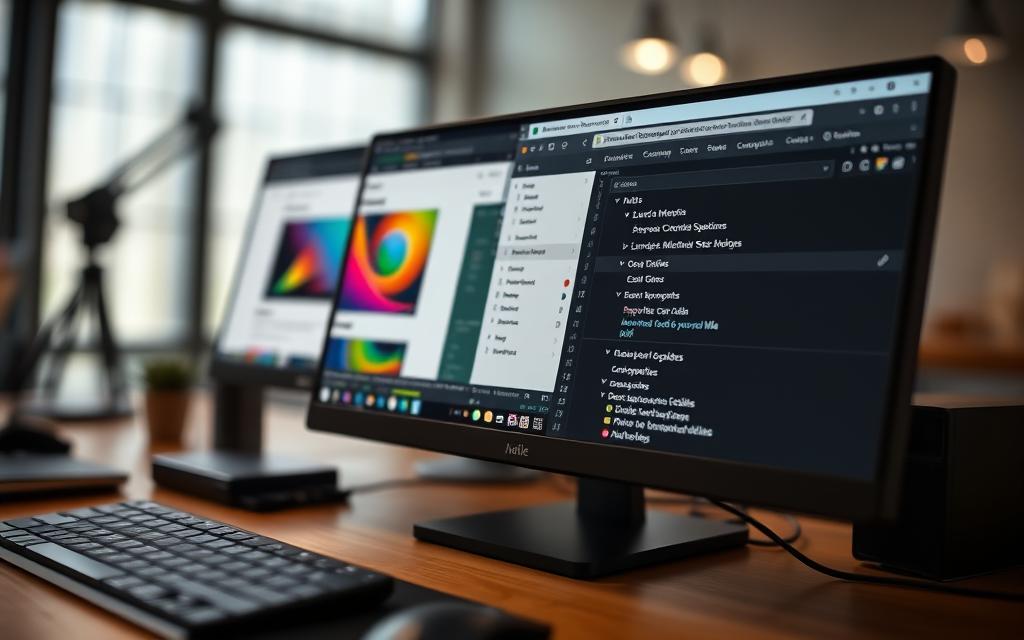Table of Contents
Mobile devices rule the browsing world today. Ensuring your website works well on all screen sizes is vital. Chrome, with its 65.12% market share, is the top mobile browser.
Web developers must test sites on real devices for the best user experience. Emulators and simulators don’t show the full picture. They can’t copy unique features of each Chrome version and device.
Testing on real devices is crucial for web developers. It gives accurate insights into website performance. Let’s explore methods to access and test mobile websites on your PC.
Understanding the Importance of Mobile Website Testing
Mobile devices dominate internet usage today. Ensuring your website’s responsiveness and compatibility is vital. Mobile testing enhances user experience, caters to device diversity, and ensures browser compatibility.
About 60% of internet traffic comes from mobile devices. Businesses must prioritise mobile-friendliness to reach customers effectively. Websites loading in one second have triple the conversion rate of five-second loaders.
Google’s algorithms favour mobile-friendly websites, boosting SEO and visibility. Font sizes, responsive layouts, and efficient media optimisation are crucial for exceptional mobile experiences.
Regular testing on various mobile devices and browsers is essential. This maintains mobile-friendliness, especially after updates or changes. It keeps your website accessible, user-friendly, and up-to-date with mobile technology trends.
| Statistic | Value |
|---|---|
| Internet traffic from mobile devices | Approximately 60% |
| Conversion rate difference between websites that load in 1 second vs 5 seconds | 3x higher for websites that load in 1 second |
| Recommended font size for desktops | At least 14 pixels |
| Average number of times individuals check their phones per day | 58 times |
| Projected number of smartphone users worldwide by 2027 | More than 7.5 billion |
| Average time smartphone users spend on their phones per day | 3 hours and 15 minutes |
| Daily smartphone usage of Millennials | More than 5.7 hours |
Mobile website testing is crucial for maintaining an accessible and engaging digital presence. It optimises your site for the evolving mobile landscape. Prioritising mobile aspects helps businesses tap into the growing market and boost their online presence.
https://www.youtube.com/watch?v=fh4hO29Lt9Y
How to Use Mobile Websites on PC Using Chrome DevTools
Chrome DevTools offers a way to simulate mobile experiences on your desktop. This is vital as more people use smartphones and tablets. [http://pcsite.co.uk/how-to-view-mobile-versions-of-websites-on-your-pc/] With these tools, you can check mobile-friendly design and functionality.
Accessing Developer Tools
Open Chrome DevTools by pressing F12 or right-clicking and selecting “Inspect”. This reveals the developer tools panel. Here, you’ll find options for testing mobile performance.
Selecting Mobile Device Profiles
In DevTools, click the “Toggle device toolbar” icon that looks like a smartphone. This activates device simulation mode. You can then choose from various mobile device profiles, including iOS and Android models.
Selecting a device shows how your website will look on that platform. This helps you spot any issues quickly.
Testing Mobile Features
Device simulation mode does more than resize the viewport. It lets you test mobile-specific features like geolocation and touch events. You can also simulate different network speeds.
This thorough testing helps identify problems users might face on mobile devices. It ensures optimal responsive design testing for your website.
Chrome DevTools simulation is a great start for mobile testing. However, it may not capture all real-world mobile nuances. For deeper insights, consider tools like BrowserStack Live.

“Chrome DevTools’ device simulation mode is a game-changer for web developers, providing a seamless way to test and optimise mobile-friendly experiences.”
Chrome DevTools helps ensure websites work well on various Chrome DevTools mobile devices. It allows designers to create visually appealing and functional sites. This leads to a better experience for mobile users.
Real Device Cloud Solutions for Mobile Website Access
Mobile devices rule the digital world today. Ensuring a smooth user experience across various devices and browsers is vital. BrowserStack Live offers a solution to this challenge.
BrowserStack Live provides access to cloud-based real devices for mobile website testing. It helps businesses avoid the limits of emulators and simulators. These often fail to mirror the true user experience on physical devices.
Teams can test their mobile websites on many iOS and Android devices. This ensures their digital presence works well across browsers and screen sizes.
- Sign up for a free trial or purchase a plan to access BrowserStack Live.
- Navigate to the Live Dashboard, where you can select the desired operating system and device-browser combination.
- Start testing your mobile website or application on a real device, taking advantage of features like multiple Chrome versions, network connectivity simulation, media testing, screenshots, and seamless integrations with popular project management tools.
Using a real device cloud like BrowserStack Live offers more than just testing. It saves time and resources by removing the need for an in-house device lab.
This approach allows thorough testing under real-world conditions. It helps deliver a flawless user experience, boosting customer satisfaction and driving business growth.
“Real device testing is essential for accurate validation of user interface, verification of hardware sensors, battery testing, CPU usage stress testing, performance testing, and in simulating real-world network conditions.”
Real device cloud testing can be a game-changer for businesses of all sizes. It helps optimise your digital presence for today’s mobile-centric world. Your customers will enjoy an exceptional user experience.
Advanced Methods for Mobile Website Simulation
Optimising websites for mobile devices is crucial in today’s digital world. Advanced methods can boost your mobile website simulation abilities. These include browser extensions and dedicated responsive design tools.
Such solutions help uncover issues affecting mobile user experience. They offer a more accurate view of your site on various devices.
Browser Extensions and Tools
Efficient mobile website testing requires specialised browser extensions and tools. These provide an immersive look at how your site appears on mobile devices.
Popular options include mobile emulators, responsive design tools, and browser extensions. Each offers unique features for thorough mobile testing.
- Mobile Emulators: These virtual environments allow you to simulate the functionality and appearance of your website on different mobile platforms, from iOS to Android.
- Responsive Design Tools: Specialised tools like the Responsive Design Mode in Google Chrome or Safari’s Development Mode can help you visualise and debug your website’s mobile responsiveness.
- Browser Extensions: Plugins such as Responsive Viewer for Chrome or Firefox Developer Tools can streamline the mobile website testing process, offering features like device emulation and real-time viewport resizing.
Troubleshooting Common Issues
Mobile website testing often reveals challenges that need careful troubleshooting. Here are some tips to help identify and solve common issues:
- Rebooting your computer once a week can help flush system memory, complete any pending Windows updates, and improve overall productivity and performance.
- Familiarise yourself with useful keyboard shortcuts, such as Windows Key + D to hide/show the desktop, Spacebar to scroll down, Shift + Spacebar to scroll up, Windows Key + Left/Right Arrow to work on two windows side by side, and Alt + Tab to switch between multiple windows quickly.
- Stay up-to-date with the latest mobile trends and optimisation best practices to ensure your website delivers an exceptional experience across all devices.
Using these advanced mobile website simulation methods can boost your testing abilities. You’ll uncover hidden issues and provide a smooth mobile experience.
| Tool | Description | Key Features |
|---|---|---|
| Mobile Emulators | Virtual environments that simulate the functionality and appearance of mobile devices |
|
| Responsive Design Tools | Specialised tools for visualising and debugging mobile responsiveness |
|
| Browser Extensions | Plugins that enhance browser-based mobile website testing capabilities |
|
Conclusion
Mobile-first design and cross-platform testing are vital in today’s digital world. Over 55% of users browse on mobile devices. The number of devices and browsers now exceeds 9,000 globally.
Real device cloud solutions like BrowserStack Live simplify thorough testing. They remove the need for managing physical devices. This helps developers create responsive websites that perform well on all platforms.
User experience optimisation and mobile-first thinking are key for businesses. They can boost online presence and tap into the growing mobile market. By 2028, mobile phone users are expected to surpass 7.7 billion.
A cross-platform optimised website is crucial for success. It drives engagement and conversions. Businesses that adapt will thrive in the mobile-dominated future.
FAQ
Why is mobile website testing crucial?
Chrome dominates the mobile browser market with a 65.12% share. Testing ensures smooth performance across various screen sizes and Chrome versions. Real device testing is essential for accurate results, as emulators can’t fully replicate unique features.
How does mobile website testing enhance user satisfaction and brand value?
Mobile website testing boosts user satisfaction and engagement, positively impacting brand value. It also shows sensitivity to accessibility issues. Testing on real Chrome browsers guarantees 100% accurate results and streamlines the process.
No website should be launched without thorough testing on real browsers and devices.
How can I view mobile versions of websites using Chrome DevTools?
To view mobile versions with Chrome DevTools, open it by pressing F12. Click the “Device Toggle Toolbar” and choose a device to simulate. The mobile view will then be displayed on your desktop browser.
This method uses simulations within Chrome, but may not replicate all real user conditions. Therefore, tests might be inconclusive.
What are the benefits of using BrowserStack Live for mobile website testing?
BrowserStack Live offers access to many cloud-based real devices for efficient mobile website testing. It provides multiple Chrome versions and network connectivity simulation. Other benefits include media testing, screenshots, and integrations with project management tools.
What are some advanced methods for mobile website simulation?
Advanced simulation methods include using browser extensions and tools. Useful keyboard shortcuts can improve testing efficiency. Windows Key + D hides/shows desktop, while Spacebar scrolls down.
Shift + Spacebar scrolls up, and Windows Key + Left/Right Arrow works on two windows side-by-side. Alt + Tab switches between multiple windows quickly. Rebooting weekly can improve system performance.









